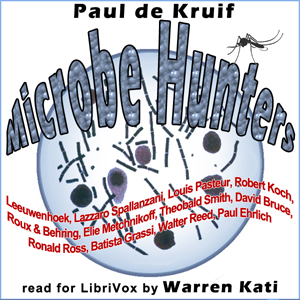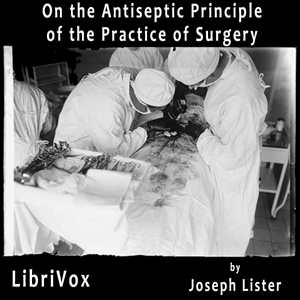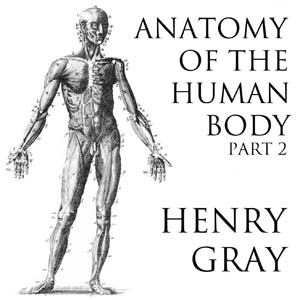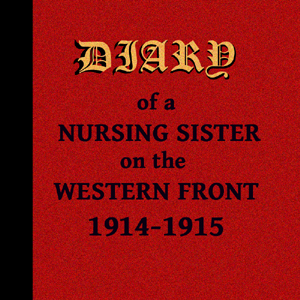- Leeuwenhoek: First of the Microbe Hunters (part 1)
- Leeuwenhoek: First of the Microbe Hunters (part 2)
- Spallanzani: Microbes Must Have Parents! (part 1)
- Spallanzani: Microbes Must Have Parents! (part 2)
- Spallanzani: Microbes Must Have Parents! (part 3)
- Pasteur: Microbes Are a Menace! (part 1)
- Pasteur: Microbes Are a Menace! (part 2)
- Pasteur: Microbes Are a Menace! (part 3)
- Pasteur: Microbes Are a Menace! (part 4)
- Koch: The Death Fighter (part 1)
- Koch: The Death Fighter (part 2)
- Koch: The Death Fighter (part 3)
- Pasteur and the Mad Dog (part 1)
- Pasteur and the Mad Dog (part 2)
- Pasteur and the Mad Dog (part 3)
- Pasteur and the Mad Dog (part 4)
- Roux and Behring: Massacre the Guinea Pigs (part 1)
- Roux and Behring: Massacre the Guinea Pigs (part 2)
- Metchnikoff: The Nice Phagocytes (Part 1)
- Metchnikoff: The Nice Phagocytes (Part 2)
- Theobald Smith: Ticks and Texas Fever (Part 1)
- Theobald Smith: Ticks and Texas Fever (Part 2)
- Bruce: Trail of the Tsetse (Part 1)
- Bruce: Trail of the Tsetse (Part 2)
- Ross vs. Grassi - Malaria (Part 1)
- Ross vs. Grassi - Malaria (Part 2)
- Ross vs. Grassi - Malaria (Part 3)
- Walter Reed: In the interest of science - and for humanity! (Part 1)
- Walter Reed: In the interest of science - and for humanity! (Part 2)
- Paul Ehrlich: The Magic Bullet (Part 1)
- Paul Ehrlich: The Magic Bullet (Part 2)
Microbe Hunters provides dramatized accounts of eleven early pioneers of microbiology and their important discoveries. Beginning in 1650 with the invention of the microscope and the first discovery of the microbial world, de Kruif chronicles how scientific knowledge builds upon itself with essays on Pasteur and Koch who demonstrated that microbes can cause disease; Metchnickoff’s discovery of an immune system that battles microbes, as well as further essays on viral and parasitic diseases such as yellow fever and malaria and the roles that specific insects play in microbial transmission. The book culminates in Ehrlich’s ca. 1910 discovery of a “magic bullet” – the first time that a drug was created that specifically targeted a microbial pathogen.
de Kruif employs a style of writing that includes semi-fictionalized accounts of each scientist’s thoughts and rationale as they work through their respective scientific hypotheses. By keeping the reader in the scientist’s head in this manner, the reader experiences the “Ah-ha!” moment along with the scientist when the groundbreaking discovery is made. Importantly, the reader need not have any science background to understand and appreciate this book.
Microbe Hunters was first published in 1926 and quickly became an international best seller. The fact that it remains in print today is a testament to its enduring appeal. Nonetheless, please be advised that there are some demeaning comments towards several racial and ethnic groups, reflecting the time period when the science was conducted or when the book was written, that would be considered racist by today’s standards. (Summary by Warren Kati)
de Kruif employs a style of writing that includes semi-fictionalized accounts of each scientist’s thoughts and rationale as they work through their respective scientific hypotheses. By keeping the reader in the scientist’s head in this manner, the reader experiences the “Ah-ha!” moment along with the scientist when the groundbreaking discovery is made. Importantly, the reader need not have any science background to understand and appreciate this book.
Microbe Hunters was first published in 1926 and quickly became an international best seller. The fact that it remains in print today is a testament to its enduring appeal. Nonetheless, please be advised that there are some demeaning comments towards several racial and ethnic groups, reflecting the time period when the science was conducted or when the book was written, that would be considered racist by today’s standards. (Summary by Warren Kati)
There are no reviews for this eBook.
There are no comments for this eBook.
You must log in to post a comment.
Log in











